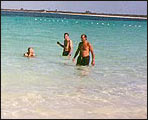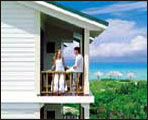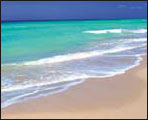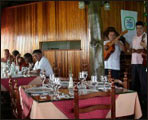With its 13 km surface,
its 11 km  of
beaches and with proper lodging, Cayo Santa Maria allows
enjoying the surroundings' numerous attractions. It is accessible
via a 48 km causeway that connects to Cairarien. A small
airport is located in Las Brujas. of
beaches and with proper lodging, Cayo Santa Maria allows
enjoying the surroundings' numerous attractions. It is accessible
via a 48 km causeway that connects to Cairarien. A small
airport is located in Las Brujas.
There are 24 snorkeling points to enjoy the remarkable
variety of coral and fish species of the virgin bottoms.
It also has infinite potential for nautical activities.
There is also an interesting project to build a tourist
resort that would offer its visitors the peaceful serenity
that provide villages located on the oceanfront. With this
resort, a central plaza built around the church and designed
to resemble the first Cuban villas with very distinguishable
elements are to be built.
Other attractions:
Other unavoidable visits in the northeast region of Villa
Clara: Cayo Ensenachos and Las Brujas.
 Located
60 km from Cayo Santa Maria is the village of San Juan de
los Remedios, declared National Monument. Towards the center
of the island, Santa Clara, the provincial capital, filled
with history, culture and hospitality. The localization
of part of the mountain range Sierra del Escambray in its
territory also makes Villa Clara one of the best tourist
attractions for nature lovers. The presence of Elguea's
thermal baths and mineral-medicinal waters leave the door
open for the ones interested in their quality of life. Located
60 km from Cayo Santa Maria is the village of San Juan de
los Remedios, declared National Monument. Towards the center
of the island, Santa Clara, the provincial capital, filled
with history, culture and hospitality. The localization
of part of the mountain range Sierra del Escambray in its
territory also makes Villa Clara one of the best tourist
attractions for nature lovers. The presence of Elguea's
thermal baths and mineral-medicinal waters leave the door
open for the ones interested in their quality of life.
A canal system is transformed in a real aquatic labyrinth
between the cayos. It offers a huge potential for enjoying
nature tourism and for nautical activities.
Another option sui generis (unique of its kind) of the region is the vessel San Pascual, made of reinforced
concrete that was run aground, seven decades ago in the
Cayo Frances region. In 1920, from the shipyard of San Francisco,
California, the ship was put back in water. Commonly known
as the El Ponton, it is considered a small island in itself
with an enviable position to appreciate the region's attractions.
of the region is the vessel San Pascual, made of reinforced
concrete that was run aground, seven decades ago in the
Cayo Frances region. In 1920, from the shipyard of San Francisco,
California, the ship was put back in water. Commonly known
as the El Ponton, it is considered a small island in itself
with an enviable position to appreciate the region's attractions.
For nature lovers, Villa La Granjita offers a welcoming
site where reins a matchless peacefulness between palm,
fruit and coconut trees.
Las Brujas (the witches) will satisfy the curiosity of
those preferring legends. The name in itself is tied to
ghosts, strange noises and stories of  apparition
that have been running from word of mouth. Others say that
it is because of stories of fortuitous loving encounters
between a fisherman and a young woman from the village.
In the city of Las Brujas - on the small island of the same
name - the beach with its very white sand, runs for almost
2 kilometers, connecting to a thermal area capable of welcoming
boats of small and medium size. apparition
that have been running from word of mouth. Others say that
it is because of stories of fortuitous loving encounters
between a fisherman and a young woman from the village.
In the city of Las Brujas - on the small island of the same
name - the beach with its very white sand, runs for almost
2 kilometers, connecting to a thermal area capable of welcoming
boats of small and medium size.
For health tourism, many attractions and singular options
are offered. Among these attractions are the medicinal baths
of Elguea, located in the northern part of the province.
The nature of this region is characterized by the high number
of endemic species, combined with hundreds of kilometers
of beautiful white sandy beaches and crystal clear water,
paths for horse back-riding, table games and its thermal
center located in a 300 square meters area where waters
have a high mineral content. The waters also contain sodium,
 bromide
and have a slight content of sulphide. The average water
temperature is of 45-Celsius degrees with a flow of 25 liters
per second. bromide
and have a slight content of sulphide. The average water
temperature is of 45-Celsius degrees with a flow of 25 liters
per second.
Villa Clara also offers an ample range of museums, cultural
centers, churches, art galleries and theaters.
In Remedio, the small musical bands playing during holidays
and celebrations are considered the oldest ones of Cuba,
dating back to 1871. Thanks to Father Francisco Vigil de
Quinones, the church's priest of Villa Juan de los Remedios,
who was worried by the absence of parishioners at the Misa
del Gallo (Mass for the rooster), decided to invite teenagers
of the village to come out with whistles, horns and other
accessories to wake up the whole town.
During celebrations, bands from different districts of
San Salvador oppose one another. The San Salvador's symbol
is a rooster of blue-green color. The symbol for El Carmen's
team is a globe of brown color.
|